Australia 2020 "Opalised Fossils"
| <prev | back to index | next> |
| Issue Date | 17.08.2020 |
| ID | Gummed | self-adhesive Michel: 5192-5195, Bl. 677 | 5196-5199, MH884 Scott: 5188-5191, 5191a | 5194-5197, 5195a Stanley Gibbons: 5332-5335, MS5336 | 5337-5340, SB718 Yvert et Tellier: 4980-4983, BF304 | 4984-4987, C4984 Category: pF |
| Designer |
Photograph: Robert A Smith from the Australian Opal Centre Ben McHenry from the South Australian Museum Stamp and minisheet design: Simone Sakinofsky, Australia Post Design Studio Product design: Jo Muré, Australia Post Design Studio |
| Stamps in set | 4 |
| Value |
$1.10- Opalised pine cone from Lightning Ridge, NSW $1.10- Opalised theropod tooth from Lightning Ridge, NSW $1.10- Opalised moon snail from Coober Pedy, SA $1.10- Opalised wood from Koroit, QLD |
| Emission/Type | commemorative |
| Issue place | Lightning Ridge, NSW 2824 |
| Size (width x height) | Stamps: 37.5mm x 26mm, Mini-Sheet: 135mm x 80mm |
| Layout | Sheets of 50, Mini-Sheet of 4 |
| Products |
FDC x2, Mini-Sheet x1, Gutter stripes x4 10 stamps each, Maxi-Cards x4, Medallion Cover x1, Booklet with 10 self-adhesive stamps |
| Paper |
gummed: Tullis Russell self-adhesive: tbc |
| Perforation | gummed: 13.86x14.6, self-adhesive: die cut 11.25 |
| Print Technique | Offset lithography |
| Printed by | RA |
| Quantity | |
| Issuing Authority | Australian Post |
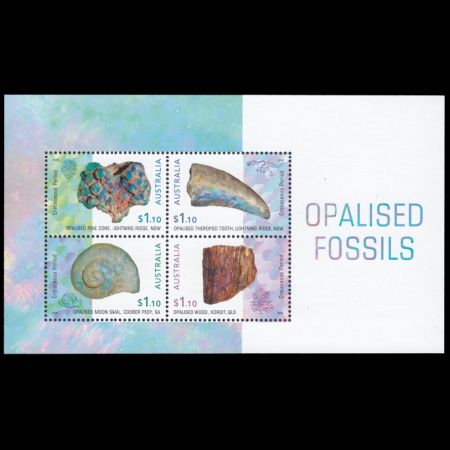
On August 17th, 2020, the Post Authority of Australia issued a set of four stamps "Opalised Fossils".
Opal is a rare and precious gemstone that boasts a stunning array of colours and patterns.
During the early Cretaceous Period, around 125 to 100 million years ago, what is now Australia lay near the South Pole, joined to Antarctica as part of the ancient supercontinent Gondwana. At that time, much of inland Australia, including the present-day opal fields of Coober Pedy, Andamooka and Mintabie in South Australia, and White Cliffs in New South Wales, was covered by the Eromanga Sea, a large, shallow body of water home to marine molluscs, fish, and swimming reptiles such as plesiosaurs. Where the opal-producing town of Lightning Ridge (about 720km northwest of Sydney) in New South Wales and the opal fields of western Queensland are now, floodplains covered with lush green forests of conifer trees and ferns were intersected by rivers flowing to the sea – a landscape teeming with freshwater invertebrates, fish, turtles and crocodiles, birds, mammals and dinosaurs.
Over millions of years, some of the plant and animal remains buried in these ancient waterways were transformed into opalised fossils. These opalised fossils formed when opal replaced buried plant or animal remains, forming replicas of their original shapes, surface textures and sometimes, internal structures. Fossils provide important insights into life on Earth, including how it has responded to changes in geology, landforms, climate and ecosystems. With only rare exceptions, Australia is the only place in the world where opalised fossils are found.
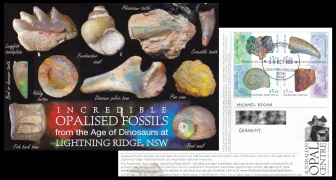
|
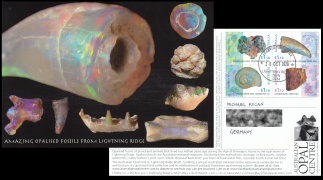
|
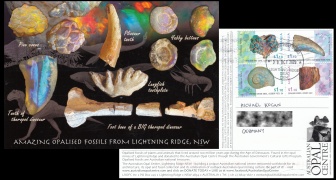
|
| Opalised fossils from collection of Australian Opal Centre from Lightning Ridge. The image is from The wonderful world of opalised fossils article of Australian Post. | ||
Opal Replacement is one type of fossilization, where the mineralized skeleton (and sometimes the soft parts!) are
preserved by replacing the original minerals of the skeleton with Opal.
Opal is a hydrous silicate mineraloid with a chemical composition of SiO2∙nH2O, with up to 20% water locked within the silica structure.
Chemically, Opal is similar to glass but with water molecules dispersed through the structure.
Over long periods of time Opal can dewater and turn into chalcedony, which has a more ordered structure.
Opal is a mineraloid because the arrangement of silicon, oxygen and water molecules is not ordered into a perfect crystalline structure.
Geologists call this state amorphous – glass is also amorphous. So unlike the mineral quartz (pure crystalline SiO2),
Opal is not going to exhibit crystalline faces or terminations.
Opal generally forms in the subsurface – precipitating from fluids in voids in the rock.
Groundwater can be enriched in silica from a variety of mechanisms – including leaching of biogenic silica-rich rocks, leaching of various silicate
minerals in sandstones and other clastic sedimentary rocks, and even from fluids released during metamorphism of rocks like basalt.
Some types of plankton, like radiolarians and diatoms naturally secrete silica.
Diatoms are tiny photosynthetic protozoans that live in marine, freshwater and even soil environments.
Their tiny shells look like petri-dishes.
Diatoms evolved sometime in the Jurassic and became common in the Cretaceous.
The biogenic silica that they make their shells out of is easily mobilized – and many older fossils of both radiolarians and diatoms look really
ragged from partial dissolution. Once the groundwater has become saturated with silica, it can start to precipitate opal.
Silica replacement (or silicification) is a more generalized term – it can include replacement by opal (Opalization or Opalisation), by
chalcedony, even by the mineral quartz. There are two end-members styles of replacement: permineralization and petrifaction.
In permineralization, the fossil is replaced at a molecular scale – as part of the skeleton is dissolved
away, new mineral material is precipitated in its place.
This style of preservation can preserve the fine ultrastructure of the body – in plants preserved this way,
one can make out individual cells in thin sections of the fossil!
The second endmember, petrifaction, is more coarse replacement.
Petrifaction generally preserves the original large-scale structure
of the fossil, but not the finer details like cellular structures. This is especially common, when the fossil was
leached out earlier forming a mold – that later filled in with opal precipitated from groundwater flowing through the
rock.
Australia supplies the vast majority of the world’s opal, their national gemstone.
Australia is the only place on earth that produces opalised bones of land-living animals including dinosaurs – and most of these are from Lightning Ridge.
In July 2016 Forbes magazine reported about the biggest and most expensive Opal found in Australia
– the “Virgin Rainbow”
“This extremely rare opal exhibits incredible fluorescence with a rainbow of different colors that make opal so
distinctly unique. The opal was found in Coober Pedy of southern Australia by miner John Dunstan, working solo in the
opal field. It is worth over $1 million and is now owned by the Southern Australia Museum in Adelaide.”
The “Virgin Rainbow” is actually an opalised fossil of Belemnite (ancient ancestor of today’s Cuttlefish) when the shape of the
prehistoric animal replaced by opal.
This stamp issue presents four opalised fossils from the early Cretaceous period – three from the collection of the Australian Opal Centre at Lightning Ridge, NSW, and one from the South Australian Museum. The stamps present a photograph of each fossil, together with a graphic motif that shows the plant or creature in its living, non-fossilised form. The graphic element down the side of each stamp is a nod to the spherical internal microstructure of opal itself.
The opal fields of South Australia have yielded a treasure trove of opalised fossils over the century, since the first discovery of precious opal at Coober Pedy in 1915. South Australian opal occurrences are chiefly restricted to the sedimentary rocks of what is now the Great Artesian Basin.
Fossils on the stamps represent the diversity of life in ancient Australia as revealed by incredible fossil discoveries from Australia's outback opal mines.
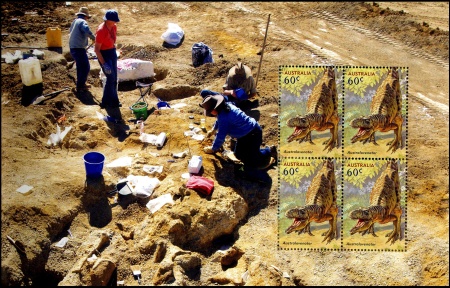
|
| Australovenator wintonensis dinosaur on stamps of Australia 2013 - a page from prestige booklet shows paleontologists at work at the dig site near Winton, Queeensland. |
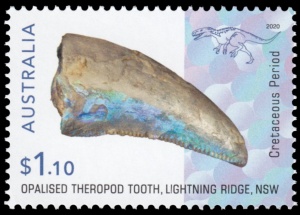 The theropod tooth fossil was found at Lightning Ridge, New South Wales.
The theropod tooth fossil was found at Lightning Ridge, New South Wales. It belongs to Australia’s largest carnivorous dinosaur, nicknamed “Lightning Claw” for the impressive size of its claws.
The hand claw would have been approximately 25cm in length and would have been used like a grappling hook to catch its prey.
Lightning Claw, who lived around 100 million years ago, is estimated at 7 meters long, larger than Australovenator wintonensis, the former largest carnivorous dinosaur found in Australia and shown on a stamp issue from 2013.
The skeleton, discovered by miners Rob and Debbie Brogan in 1990, consists of a foot bone, parts of the hip, ribs, forearm, and a giant claw from the hand. Unfortunately, it is too little to raise the banner of a new genus or species, therefore it went unidentified for two-plus decades. When a team of researchers from Italy and Australia decided to reexamine them, they found a specimen worthy of a new name and classification.
"I immediately recognised this fossil was something new," Phil Bell, a researcher at the University of New England, in Adelaide, said in a press release that published on September 9th 2015 on the website of the University.
Dr. Phil Bell, is an authority on Australian dinosaurs, "duck-billed" hadrosaurs and dinosaur skin, although his research covers a wide range of dinosaurs and other Mesozoic vertebrates.
"When I compared it to other Australian and South American dinosaurs, it was clear it was a megaraptorid which is relatively rare group of dinosaurs, mostly known from Argentina."Even though, the dinosaur doesn’t have a scientific name yet, there’s enough of the fossil to tell that the dinosaur was one of the megaraptorids – large, predatory dinosaurs that bore extra-long claws on their hands.
In 2013, opalised fragment of lower jaw of an ornithopod dinosaur found at Wee Warra opal mine near Lightning Ridge town. Opal dealer Mike Poben, from Adelaide, first recognized it as a fossil, after acquiring it in a bag of rough opals received from the miners. He donated it to Australian Opal Centre, which has the world's largest collection of opal fossils, and was honored in the species name.
The new dinosaur genus named Weewarrasaurus pobeni by Phil Bell, who published his study on December 4th 2018.
The dinosaur lived in the Cretaceous Period about 100 million years ago and is part of a group of plant-eating dinosaurs called ornithopods (dinosaurs with beaks). It may have moved in herds or small groups for protection. The fossil adds to growing evidence that the plant-eating fauna of the Southern Hemisphere consisted of quite different creatures than the Cretaceous herbivores of North America, such as the numerous horned relatives of Triceratops and the duck-billed hadrosaurs.
“The new discoveries can help us understand the connections, possible migrations, and the relationship of the small bipedal herbivorous dinosaurs of South America, Antarctica, and Australia during the Cretaceous,” says Penélope Cruzado-Caballero, an expert on herbivorous dinosaurs at the National University of Río Negro in Argentina.
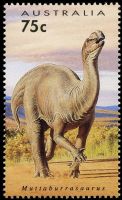 In 2019 new dinosaur species reported from Australia, based on opalised fossils unearthed near Lightning Ridge.
In 2019 new dinosaur species reported from Australia, based on opalised fossils unearthed near Lightning Ridge.The newest species, Fostoria dhimbangunmal, was an Iguanodon-like dinosaur that lived about a hundred million years ago during the mid-Cretaceous period, when this region was a broad floodplain with lakes and rivers flowing into the inland Eromanga Sea.
The name Fostoria honors opal miner Bob Foster who found it in 1984 and donated it to the Australian Opal Centre, dhimbangunmal means ‘sheep yard’ in the local Yuwaalaraay and Yuwaalayaay Aboriginal languages. The fossils were prepared but remained unstudied until 2015.
A relative of Australia’s most famous dinosaur, Muttaburrasaurus that appeared on Australian stamp in 1993, Fostoria is also an early member of a group that would elsewhere evolve into the duckbilled hadrosaurs, which were common in North America and Asia toward the end of the time of the dinosaurs, roughly 66 million years ago.
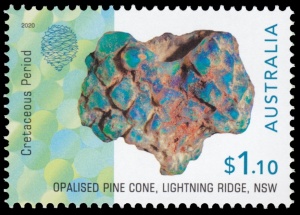 The pine cone fossil featured on the stamp was also found at Lightning Ridge,
New South Wales and is part of the collection of the Australian Opal Centre, a not-for-profit museum, research and
cultural centre, which houses a diverse collection of opalised fossils and precious opal.
The pine cone fossil featured on the stamp was also found at Lightning Ridge,
New South Wales and is part of the collection of the Australian Opal Centre, a not-for-profit museum, research and
cultural centre, which houses a diverse collection of opalised fossils and precious opal. The pine cone species was likely a relative of today’s Bunya Pine (Araucaria bidwillii), a tree in the Araucarian conifer group, prevalent during the Cretaceous period in Gondwana.
100 million years ago, Lightning Ridge was heavily forested with conifers such as Araucarian, podocarp and Kauri pine trees, towering over ferns, seed ferns and ground pines, fungi and lichens, mosses, liverworts and horsetails.
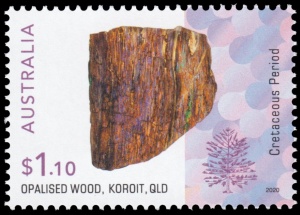 The opalised wood featured on the stamp was found in Queensland’s Koroit opal fields, a rich source of boulder
opal (opal found in ironstone boulders). While the identity of the tree species is unknown, like the pine cone fossil,
it also was likely from a species in the Araucarian conifer group.
The opalised wood featured on the stamp was found in Queensland’s Koroit opal fields, a rich source of boulder
opal (opal found in ironstone boulders). While the identity of the tree species is unknown, like the pine cone fossil,
it also was likely from a species in the Araucarian conifer group. Araucarians – also known as Araucariaceae – is a very ancient family of coniferous trees, which is still exist today. The family achieved its maximum diversity during the Jurassic and Cretaceous periods, when it was distributed almost worldwide.
Most of the Araucariaceae in the Northern Hemisphere vanished in the Cretaceous–Paleogene extinction event, and they are now largely confined to the Southern Hemisphere, except for a few species of Agathis in Southeast Asia.
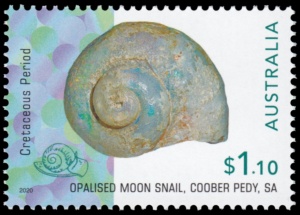 The moon snail, a 100 million year old fossil found at Coober Pedy, South Australia is currently on display at the South Australian Museum.
The moon snail, a 100 million year old fossil found at Coober Pedy, South Australia is currently on display at the South Australian Museum.This moon snail species, Euspira reflecta, is the most common opalised fossil snail species in the region.
This member of the Naticid family was an active sea-floor predator, preying on sessile molluscs such as mussels and cockles.
Euspira would use its file-like teeth (radula) to drill a hole through the bivalve shell, on the sandy sea-floor of the ancient sea that covered almost a third of Australian continent during the Early Cretaceous. Once the hole is made, it would insert a its long proboscis into the mussel and then eat its victim from the inside out.
Opalised cockles and mussels exhibiting the tell-tale hole drilled by Euspira are also frequent discoveries at Coober Pedy.
According to Australian Opal Centre (AOC),
in June 2019, a researcher from Australia Post Philatelic contacted the AOC with the idea of some stamps featuring opalised fossils.
They were so excited as they were thinking about opalised fossil stamps for years!
The AOC provided a selection of opalised fossil photographs by Robert A. Smith for the Australia Post team to choose from.
They also suggested that the stamps represent the opal fields of South Australia and Queensland as well as NSW, because
opal is the Australian National Gemstone and opalised fossils are Australian National Treasures to be shared with everybody;
and they put Australia Post in touch with the South Australian Museum so it could be involved too.
“Australia’s opalised fossils provide rich insights into the history of life on our ancient continent – into how
Australia, its geology, landscapes, plants and animals came to be as they are, and how fortunate we are to live in this
remarkable place." - Jenni Brammall, AOC Special Projects Officer.
“I’m excited and proud! Opal fossils are one of the nation’s wonders and this is a great chance to bring their story to
the Australian public." - Ben McHenry, Senior Collections Manager for Earth Sciences at the South Australian Museum.
Of course there are dozens of other opalised fossils worthy of postage stamps, perhaps they will be a subject for some future stamps.
Products and associated philatelic items
| Mini Sheet | Gutter stripes | Self-adhesive stamps issued in booklets of 10 and 20 |

|
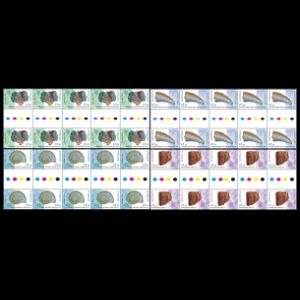
|
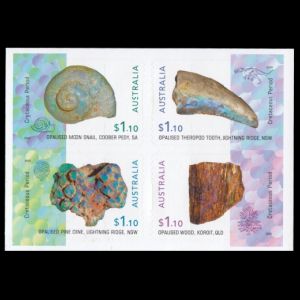
|
|
FDC with single stamps and the Mini-Sheet produced on the same cover. |
Circulated, customized FDC
with both mint (on the right) and self-adhesive (on the left, rotated) stamps. |
|
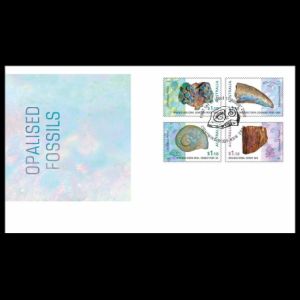
|
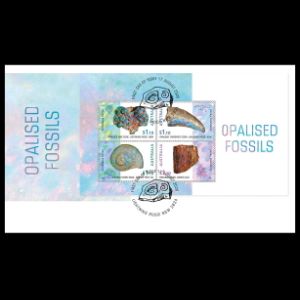
|
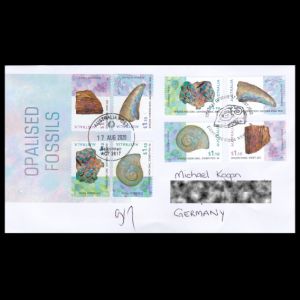
|
|
|
||
|

|

|
| Some other Philatelic Souvenirs | ||
| Medallion Cover (reverse side is here) | Presnation Pack | Maxi Cards (reverse side is here) |

|

|

|
| Impressions Collection, only 200 of every item produced | ||
| Limited Edition Medallion cover with an Australian opal insert |
Opalised Fossils Minisheet Collection the folder includes four digitally printed gummed and perforated minisheets |
|

|

|

|
|
Stamp on cover Opalised Moon Snail from the Opalised Fossil stamp issue, released 17 August 2020 |
Stamps and selvage are foiled in a clear holographic |
|
References
Australian Post: Opalised Fossils, The wonderful world of opalised fossils, Stamp Bulletin Nr. 366 (PDF),

|
Opal and Opalisation: Encyclopaedia Britannica, Wikipedia, Virgin Rainbow Opal by Forbes, How is Opal formed ?, Opal by mindat.org, "OPALISATION OF FOSSIL BONE AND WOOD: CLUES TO THE FORMATION OF PRECIOUS OPAL" (PDF) by Benjamath Pewkliang, Allan Pring, Joel Brugger
Australian Opal Center: home page, facebook page, Opalised Fossils
South Australian Museum: home page
"A large-clawed theropod (Dinosauria: Tetanurae) from the Lower Cretaceous of Australia and the Gondwanan origin of megaraptorid theropods" by Phil R. Bell, Andrea Caub, Federico Fanti, Elizabeth T. Smith.
Additional Videos:
Weewarrasaurus pobeni: National Geographic, BBC, Insider, Wikipedia,
Fostoria: National Geographic, Wikipedia, Popular Mechanics,
The moon snail: InDaily, Australian Opal mining and Exploration,
Araucarians: Wikipedia,
Acknowledgements
Many thanks to Dr. Peter Voice from Department of Geological and Environmental Sciences, Western Michigan University, for his help to find an information for this article, the draft page review and especially for the text about opalisation process written by him.| <prev | back to index | next> |